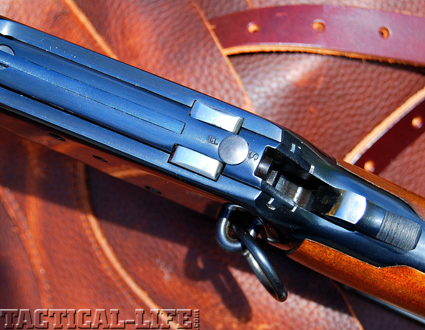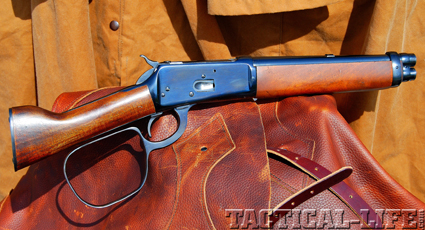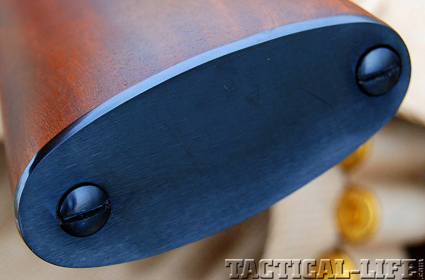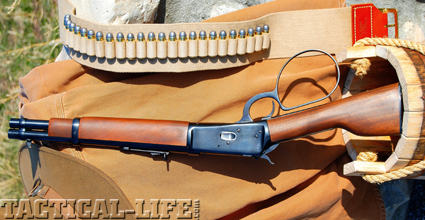Rossi’s Ranch Hand enters the Mare’s Leg market with a stylish version of the original Wanted: Dead Or Alive lever-action pistol in .357 Mag, .44 Mag, and .45 Colt calibers.
Steve McQueen’s iconic Wanted: Dead Or Alive Mare’s Leg has to be one of the most intriguing guns ever to come out of a Hollywood prop department. Most of the guns toted by celluloid heroes of the fictionally portrayed Old West tended to be Colt Peacemakers, with an occasional derringer tossed in, but John Wayne and Chuck Connors bucked the trend with their ringlever Winchesters; instantly cementing a place for those 92s forever in the minds of the classic lever-action fans who watched them on big screen or small. It was refreshing to see them used for something besides a herd of hombres pouring hot lead into the cabin our intrepid leading man was barricaded in, or sniping a lone rider off his horse from half a mile out in a high mountain pass ambush. Whereas previously the Winchester had been mostly a dastardly bad guy gun, those two men rehabilitated it to official good-guy status. Taking it even further, when McQueen began the role of Josh Randall that made him a star, he took that cut-down Model 92 in its custom spring-clip holster rig along with him, and certain grey-bearded old fogies today still argue that the real star of Wanted: Dead Or Alive was made of wood and steel, not flesh and bone.
Over the years since Wanted left the air in 1961, hardcore fans of the concept with enough motivation, moxie, and moolah to plod through the legal process have paid for replicas of Josh Randall’s Mare’s Leg to be built based on original Winchester and imported 92 variations. It was not exactly a common occurrence though, entailing government forms, fingerprint cards, a $200 tax stamp fee, and several months of waiting for approval by return mail—plus the cost of the initial gun in full-length form and then finding a gunsmith who could do the bobjob. Unsurprisingly, alternative trails to reach the same general destination were pursued, which eventually resulted in the Bureau of Alcohol, Tobacco, Firearms, and Explosives’ approval to manufacture and sell Mare’s Leg configurations using frames that had never been used in a rifle or carbine. The key point that made a cutback levergun into a federal case was that it fell under the National Firearms Act of 1934, prohibiting possession of machineguns and sawed-off shotguns and rifles without passing through the necessary governmental process. Since a brand new frame can go either way, designating and building one for handgun use from the start removes it from NFA status and opens it up for the public at large to buy and possess with no more paperwork than with any other handgun. And, no need to spend hundreds more on a custom gunsmith. (Desire, however, is another matter.) This was very much a “Hmmmm….” moment for many who’d given up on the idea of ever owning an actual cartridge-firing Mare’s Leg because of the process and costs involved.
Advertisement — Continue Reading Below

Wing safety and sights removed, forend wood barrel shortened to just under 9 inches.
Credit for tossing big logs on a small fire has to go to J. B. Custom for his Mare’s Leg, beginning in 2005 and more recently Legacy Sports with their 2009 introduction of the Italian Chiappa-made Bounty Hunter, but both of those are fairly pricey guns. Still, people are buzzing and people are buying—so Rossi decided that since they’d been manufacturing Model 92 variations in Brazil for decades anyway, they might as well hitch their wagon to the mare early on in the race. In 2010, they announced the new Ranch Hand in .38 Special/.357 Mag, .44 Mag, and .45 Colt; each with a suggested retail price of $536, less than half of what the other two companies charge for their models. As it comes, it’s a shooter, and if you want a bit more authenticity, it can be the basis for a great custom project.
Gun Details
Advertisement — Continue Reading Below
Out of the Rossi box, the Ranch Hand measures 24 inches stem to stern. Furniture is a stained Brazilian hardwood fore and aft, all external steel surfaces are blued, sights are a tall front blade topped by a brass bead with a traditional buckhorn setup at the rear, the stock’s capped with a smooth steel plate, the lever’s oversized, and Rossi includes a saddle ring on the left side and a winged rotating safety on top of the bolt. Like the other two outfits, Rossi figures you’ll enjoy shooting more than you’ll enjoy loading, so the pistol comes with a 12-inch barrel to allow a six-shot tube magazine for a total 7-round capacity with one in the chamber. Technically, that also makes it at least marginally competitive at Cowboy Action matches as a handgun, capacity-wise if not speed-wise, as opposed to what you’d end up with in a shorter factory configuration closer to what the TV gun had. (You’ll only load with five anyway for CAS matches.) If you’re not a cowboy shooter, it’s still nice to have 7 rounds at hand. At the rear end, the stock’s “nub” is noticeably longer than Randall’s TV gun, and between it and the longer barrel the gun doesn’t quite have the same profile. Also, all current Rossi 92 versions, no matter which importer contracts for what features, now have that safety. Earlier models didn’t, and frankly it’s an eyesore.

Modified Ranch Hand’s profile after gunsmith Steve Young’s efforts is much more authentic to the Wanted: Dead Or Alive Hollywood prop gun.
Overall, the Ranch Hand is nicely done with great visual appeal, sights that can be drift-adjusted for windage and step-adjusted for elevation, and a better fit and finish than previous Rossi 92s I’ve worked with. The action was relatively stiff to begin with, as the Rossis normally are.
Advertisement — Continue Reading Below
Shooting Impressions
This is probably a good time to admit that the whole idea in getting the Ranch Hand, for me, was to customize it. With dealer level pricing running under $400, the Rossi just about begs for bobbing. Still, not everybody will go that route, so before the gun was sent off it spent an afternoon in the gravel pit with two CAS-level factory lead loads, one “serious” standard pressure commercial lead semi-wadcutter hollowpoint, and two CorBon thumpenboomers, to test for 25-yard accuracy for those interested here.
Off an Outers Pistol Perch, with the 250-grain lead Winchester and Black Hills cowboy loads recoil was mild to begin with and the weight of the gun itself made it very pleasant to shoot. Federal’s 225-grain LSWHP is a more practical round for .45 Colt defensive uses along the trail, but still a soft shooter in the Rossi. Ramping up to the thoroughbred CorBons, though, was another matter entirely. While the Browning-designed Model 92’s twin locking bars create a very strong action fully capable of safely handling hotter loads and higher-than-normal .45 Colt pressures, the angle of the stock wrist isn’t conducive to hanging on effectively, and the gun will jump straight for your head. Anticipating that, I had my left hand braced against the stock’s steel plate, between it and my favorite eyeball, with the right hand firing the Ranch Hand.
Advertisement — Continue Reading Below
The first shot of the 300-grain Jacketed Soft Point +P CorBon smacked my left palm so hard that the rest of the CorBon testing was done with a wadded up glove between it and the buttplate. Just to show the Rossi who was boss, I did fire exactly one CorBon on my feet two-handed. With both hands wrapped around the stock’s wrist in a roughly conventional eye-level handgun hold, the left index finger was promptly and smartly banged a good one by the forward interior curve of the lever. Since the purpose of this go-round was to test for intrinsic accuracy, no hipshots were done and no steel plates were harmed during the session.
There are some conclusions worth mentioning. First, bench accuracy is more than good enough for practical uses and occasions where you may want to actually hit something at a distance with one of these. The front brass bead is very visible, but I found it too wide to fit completely in the rear notch, and consequently harder than normal to get things lined up precisely for repeatable accurate windage sight pictures. Few will use it for slow-fire bull’s-eye competition, though; for plinking it’s not a problem. Second, keep the gun well away from your noggin when you fire it, even with relatively lighter loads. The “grip” angle is not the same as a normal handgun, and the Mare’s Leg reacts differently under recoil. It’ll try to come straight back, and you don’t have the same solid grip on it. Third, resist the temptation to try to make it into a shoulder gun, as that puts things hazardously close to valuable facial real estate, and also ignore the temptation to rest any part of the gun against said real estate while trying to choke up on the sights. This is not a rifle, don’t try to shoot it like one—especially with hot loads. Fourth, you’ll achieve better free-standing accuracy by a two-hand hold back on the stock wrist, not with one hand on it and the other forward on the wood forend. Keeping your hands together instead of separated should give you less-muzzle wobble.
Custom Details
Advertisement — Continue Reading Below
Steve Young, “The Rossi Specialist” down in Texas, is the man for slicking up a Rossi 92, and shortly after the gravel pit session was done off it went, with a list of requests.
The top two were the length and the wing safety. Initially, I asked for 2 inches off the front and 2 inches off the back to bring it closer to “Randall” dimensions. The barrel would have still been a shade over-extended, but I didn’t want to lose more than two rounds in the magazine and did not want a “four-shooter,” which is what I thought I’d end up with if we tried to duplicate the Wanted: Dead Or Alive gun dimensions more closely. Since Steve offers a remedy for that safety as part of the action work he does on guns sent to him, removing the part and replacing it with a steel plug that fills the hole in the bolt was no problem. (I consider the half-cock hammer system originally used in the ‘92 design a perfectly safe way to use the gun without an ugly wingnut on top.)
From there, since Josh Randall’s Mare’s Leg had no sights, the Rossi couldn’t either. This obviously renders the gun more of a pointer than an aimer, but since I have no intentions of ever using the altered Rossi for anything more than the sheer fun factor it embodies, it and I can get along without ‘em. The steel stock cap also had to be replaced with a smaller one.
Advertisement — Continue Reading Below

Factory steel stock plate is well-fitted on the Rossi Ranch Hand.
The Wanted gun was used in two versions during the series’ run, the first was a round-barrel with a squared lever, the second had an octagon barrel and a wedge-shaped lever. To stay closer to the first, I asked Steve to bend the contour of the Ranch Hand’s rounded lever as best he could to match, and to slightly break the inside edges in that lever to be more comfortable in hand. The final requests were to round off the bottom of the trigger tip to avoid potentially puncturing a coordination-challenged trigger finger on closing the action in a hurry, and do the same to the hammer corners. The idea was smooth, non-gouging, and relatively snag-free operation.
Steve astounded me by pulling off an 8.88-inch barrel with a corresponding magazine length and capacity of five, meeting my original six-shot goal (with one chambered) but with a 3-inch reduction in barrel length instead of the 2-inches I originally thought I’d have to settle for. This required some internal magic involving replacing the factory plastic follower with one of his own stainless steel versions, shortening it, modifying the magazine tube end cap, and shortening the follower spring. The result also allowed him to configure the snout with both barrel bands close together and shorten the wood forend appropriately to match the Hollywood Mare’s Leg profile.
Advertisement — Continue Reading Below
The rear sight dovetail was filled with a plug, same on the bolt-top wing safety hole, hammer and trigger were de-fanged as requested, the lever was shaped as close to the original Type 1 Wanted: Dead Or Alive contour as possible without cutting and re-welding with additional material (it’s about an inch shorter), and the inside edges are now much more comfortable when working it. The stock nub is markedly nubbier, with a new steel cap fabricated and fitted. Overall length is a trim 19.375 inches at 4.19 pounds. Steve’s action job slicked up the lever throw, and left a clean creepless 3.5-pound trigger pull.
Range Time
How does it shoot? A little over two hours after it was dropped off at my door, it was headed up the hill behind the house with several boxes of Winchester’s 250-grain LFN cowboy loads to find out. Can it hit anything without sights? Did that bobbed magazine affect reliable feeding? Most certainly, and definitely not. After setting up steel plates at 10 yards and my small steel buffalo silhouette at 30 yards, the modified Rossi showed that it’s not at all hard to ring steel at both distances on a regular basis standing upright and supported by nothing but two legs. I won’t put this gun on paper again, but by lining up the receiver bridge outline with the top of the rear barrel band outline, and aiming low as needed at varying distances (it shoots the Winchester load about 6 inches high at 10 yards, and over a foot high at 30 yards), plinking and plonking is very doable. You won’t come in first at a CAS match with a brace of these, but you can manage typical match pistol target distances while earning serious style points, and with some practice hip-shooting can be fairly accurate at 5 yards or so for non-CAS gun fun. For an original WDOA fan then and an over-grown kid now, this is super cowboy cool.
Advertisement — Continue Reading Below
Much as I like the original spring-clipped TV holster rig, Bob Mernickle crafts far more practical Mare’s Leg leather in either a complete slotted gunbelt and holster combo at $399.95 or a holster alone for $165.95. Right or left-handed in a double thickness and russet color, with a partially cut-out front for an easy draw, an open toe and a high leg tiedown thong. Specify which side and gun on ordering, especially if it’s for this “sightless” Mare’s Leg. The holster done for the project fits the custom Rossi perfectly and it’s tight enough for excellent retention.
And I thought the toy rig I had in 1960 was fun…























